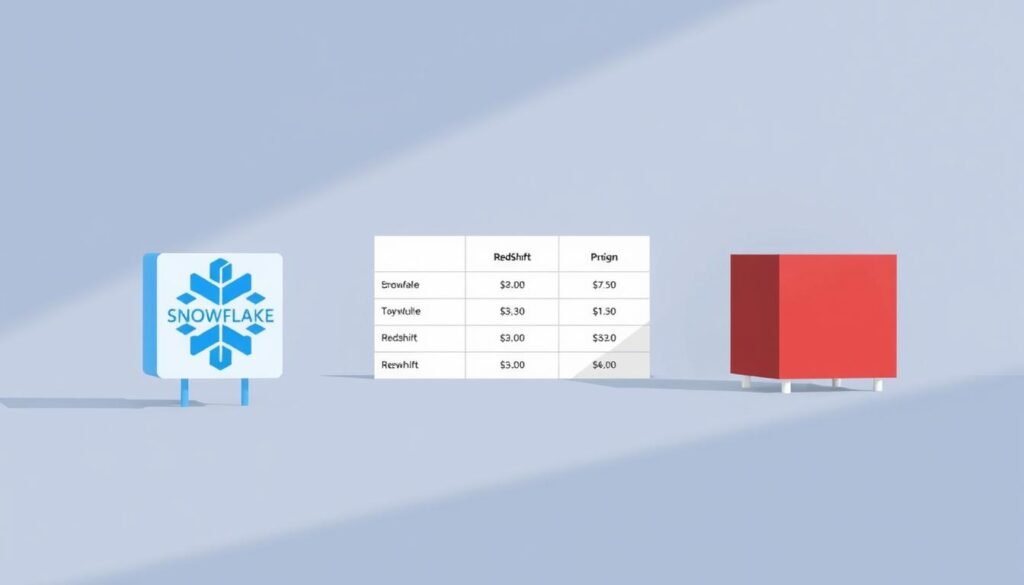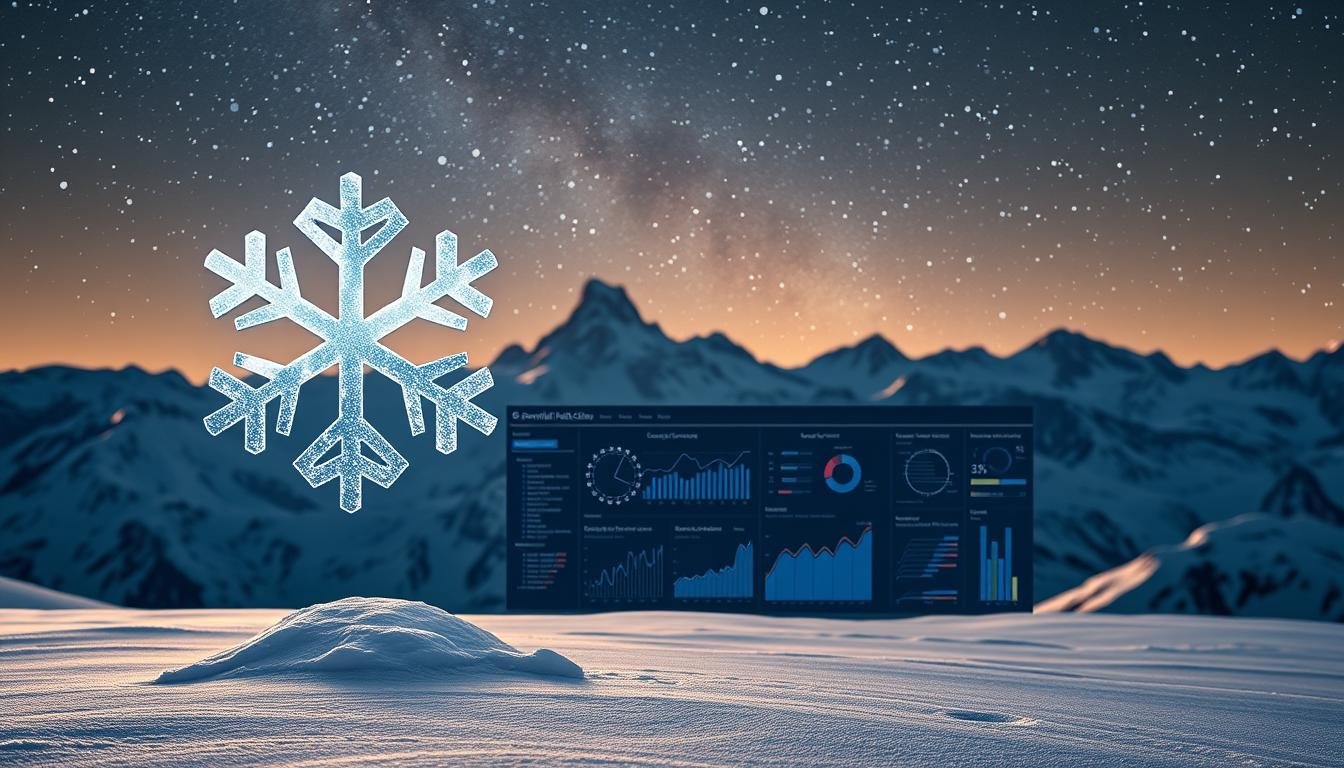Are you trying to pick between Snowflake and Redshift for your cloud data needs? Choosing the right platform is key in today’s fast-changing data world.
Snowflake vs Redshift is a big choice for businesses. These tools change how companies handle big data. They make storing, processing, and analyzing data easier.
I’ve looked into both Snowflake and Redshift a lot. I know their good points and what might not work so well. Picking between them is more than just looking at features. It’s about finding the best fit for your business.
Table of Contents
Key Takeaways
- Snowflake and Redshift are leading cloud data warehouse solutions
- Performance and scalability differ significantly between platforms
- Each solution offers unique architectural advantages
- Cost and integration capabilities vary widely
- Selecting the right platform requires deep understanding of organizational needs
Understanding Cloud Data Warehouse Solutions
Data warehousing has changed a lot with cloud computing. Businesses face huge data growth. Cloud solutions help manage and analyze big data.
Now, companies use cloud data warehousing to solve old problems. These new platforms offer great flexibility and growth for data handling.
Defining Cloud Data Warehouses
A cloud data warehouse is a big digital place for data. It stores and analyzes lots of data. Cloud solutions are different from old systems because they:
- Grow easily
- Cost less to use
- Work well with many data sources
- Do analytics fast
Evolution of Data Warehousing
From old servers to cloud platforms is a big step. My work in data shows how cloud changed data storage and use.
| Era | Data Storage Method | Key Characteristics |
|---|---|---|
| Traditional | On-premises servers | Limited scalability, high infrastructure costs |
| Cloud Transition | Distributed cloud platforms | Unlimited scalability, reduced operational expenses |
Benefits of Cloud-Based Solutions
Cloud data warehousing helps businesses deal with big data better. The tech removes hardware limits and gives strong computing power when needed.
- Fast data processing
- Less money for setup
- Strong security
- Accessible worldwide
As data gets more important for making decisions, cloud data warehousing is the future for big companies.
Introduction to Amazon Redshift
Amazon Redshift is a strong cloud data warehouse. It changes how companies handle big data. It’s a fully managed service in AWS, giving great performance for big data queries.
When we look at aws redshift vs snowflake, Redshift is special. It uses columnar storage and MPP for big data. This makes it very good at handling lots of data.
- Fully managed cloud data warehouse service
- Supports complex analytical workloads
- Designed for high-performance data processing
- Seamless integration with AWS infrastructure
Amazon Redshift can make data smaller and faster. It helps companies grow their data warehouse quickly. They only pay for what they use.
| Feature | Amazon Redshift Capability |
|---|---|
| Storage Type | Columnar Storage |
| Processing Architecture | Massively Parallel Processing (MPP) |
| Data Compression | Advanced Encoding Techniques |
| Scalability | Petabyte-Scale Processing |
Many businesses use Amazon Redshift. They turn data into useful insights. It’s key for making smart decisions based on data.
Deep Dive into Snowflake Architecture
Snowflake architecture is a new way to handle data in the cloud. It changes how companies deal with data. Snowflake makes data work better for today’s businesses.

Snowflake’s design is its biggest strength. Old data warehouses had trouble growing and working well. But Snowflake fixed these problems with its new design.
Multi-Cluster Shared Data Architecture
Snowflake’s design makes it easy to grow and work better. It has special features like:
- Dynamic resource allocation
- Independent scaling of compute and storage
- Automatic query optimization
- Zero-copy cloning capabilities
Separation of Storage and Compute
Snowflake’s design splits storage and compute into two parts. This lets businesses:
- Scale computing power independently
- Reduce infrastructure costs
- Optimize resource utilization
- Improve overall system performance
Advanced Data Sharing Capabilities
Sharing data is easy with Snowflake. Companies can share data safely across different accounts. They don’t have to move or copy data.
Snowflake’s data sharing model eliminates traditional data synchronization challenges, enabling real-time collaboration and insights.
Snowflake’s design is made for the cloud. It gives companies a strong, flexible, and affordable way to store data. It meets the changing needs of businesses.
Snowflake vs Redshift: Core Feature Comparison
When we look at Snowflake and Redshift, we see many important features. These cloud data warehouse solutions are very powerful. But, they work in different ways, showing their own strengths.
Let’s talk about the main things to compare:
- Data Storage Formats: Both use columnar storage. This makes data compression and query speed better.
- Processing Capabilities: They both use MPP architecture. This helps with big analytical tasks.
- Data Type Support: They handle structured and semi-structured data well.
Snowflake stands out with its multi-cluster architecture. It lets you scale storage and compute separately. This is different from Redshift’s traditional way.
Redshift is great for those who use Amazon Web Services a lot. Snowflake works with many cloud platforms, not just one.
The right choice depends on your specific data infrastructure, performance requirements, and existing cloud strategy.
When deciding, think about how well each performs and their costs. This will help you choose the best cloud data warehouse solution for you.
Performance and Scalability Analysis
Cloud data warehouses need to work fast and grow big to meet business needs. Snowflake and Redshift have different ways to manage work and speed. This affects how companies use data.
Looking at performance, we see important differences between these platforms:
Query Performance Metrics
How fast queries run is key for data warehouses. Snowflake and Redshift handle workloads in different ways:
- Snowflake can scale instantly, adding resources right away
- Redshift takes minutes to add new nodes
- Both use MPP architecture for speed
Concurrent User Access
When many users need data at once, scalability matters. Snowflake’s design handles many queries well without slowing down.
Performance isn’t just about speed, it’s about consistent, reliable data access across complex organizational needs.
Resource Management
Managing resources well is key for fast queries. Snowflake splits storage and compute, giving more control. Redshift uses nodes for scaling.
Choosing between Snowflake and Redshift depends on what your company needs, how you work, and what you expect from performance.
Pricing Models and Cost Considerations

Pricing is key when picking cloud data warehouses. Snowflake and Redshift have different pricing models. These models can change how much you spend.
Snowflake uses a credit-based system. It charges for compute and storage separately. This lets businesses adjust costs as needed.
Redshift bundles compute and storage costs. It offers good deals for long-term plans:
- Big discounts for reserved instances
- Node-based pricing model
- Predictable monthly bills
| Pricing Aspect | Snowflake | Redshift |
|---|---|---|
| Pricing Structure | Credit-based | Node-based |
| Storage Pricing | Separate charging | Bundled with compute |
| Scalability | Highly flexible | Fixed node configuration |
Choosing between Snowflake and Redshift depends on your needs. Think about your data, users, and queries. This helps find the best deal.
Do a deep cost analysis for your business. Snowflake gives detailed control, while Redshift is simpler for steady workloads.
Security and Compliance Features
Data governance and security are key when picking a cloud data warehouse. Snowflake and Redshift have strong protection to keep your data safe. They protect it in many ways.
Companies need strong security plans. These plans should keep data safe and work smoothly. Here are important details about the security of these top cloud data warehouses.
Authentication Methods
Today, we need smart ways to log in. Both Snowflake and Redshift offer many ways to log in:
- Single Sign-On (SSO) integration
- Multi-factor authentication
- Role-based access control
- LDAP and Active Directory synchronization
Encryption Standards
Encryption is the first step in keeping data safe. Snowflake and Redshift use strong encryption:
- AES 256-bit encryption
- End-to-end data protection
- Network-level security protocols
- Automatic encryption key management
Regulatory Compliance
Following rules is hard. But these platforms help with important rules:
- HIPAA for healthcare data
- PCI DSS for financial transactions
- GDPR for European data protection
- SOC 2 Type II certification
Choosing the right cloud data warehouse is important. Knowing about their security helps companies make good choices. They can find a balance between fast work and keeping data safe.
Data Integration and Migration Capabilities
Dealing with data integration and migration is tough. Cloud data warehouses like Snowflake and Redshift make it easier. They help move and change data in different places.
Businesses need to update their data systems. Both Snowflake and Redshift have tools for easy data integration. They work with many sources, such as:
- On-premises databases
- Cloud storage systems
- Streaming data platforms
- Legacy enterprise systems
Looking at data integration, Snowflake and Redshift stand out. Snowflake’s design lets data move smoothly without slowing down. Redshift uses AWS to make data movement easy.
| Feature | Snowflake | Redshift |
|---|---|---|
| Native Connectors | Extensive third-party support | AWS service integrations |
| Data Transformation | Built-in SQL transformation | AWS Glue ETL support |
| Migration Speed | High-performance parallel processing | Optimized for AWS workloads |
Choosing the right data integration depends on your needs. Check if Snowflake or Redshift fits with your data system. This ensures a smooth move.
Maintenance and Administration Requirements
Database administration and maintenance are key for cloud data warehouse performance. Snowflake and Redshift manage system operations differently. Each has strengths that affect database management efficiency.
Understanding the maintenance landscape is important. We’ll look at how each platform handles database administration tasks.
Automated Management Strategies
Snowflake is known for its strong automation. It makes database maintenance easier with:
- Automatic data compression
- Self-managing storage optimization
- Seamless system updates
Hands-On Management Approaches
Redshift needs more direct help from database admins. Important maintenance tasks include:
- Manual performance tuning
- Regular vacuum and analyze operations
- Proactive cluster management
System Updates and Patching
When choosing, think about maintenance needs. Snowflake’s cloud-native design needs less manual work. Redshift needs more hands-on effort.
Good database maintenance is about keeping things simple.
Deciding between Snowflake and Redshift depends on your team’s skills. It also depends on how much you want to manage database maintenance.
Use Cases and Industry Applications
Snowflake and Redshift have changed data warehousing in many fields. They offer strong solutions for tough data problems. These cloud tools help companies use advanced analytics and business smarts in flexible ways.
Each platform has special strengths for different areas:
- Financial Services: Handling complex transaction data and risk analysis
- Healthcare: Keeping patient records and research data safe
- Retail: Studying customer habits and managing stock
- Technology: Handling real-time data and machine learning tasks
There are key examples showing what each platform does best:
| Industry | Snowflake Strengths | Redshift Strengths |
|---|---|---|
| Financial | Advanced data sharing | Cost-effective batch processing |
| Healthcare | Secure multi-tenant architecture | Compliance-ready infrastructure |
| E-commerce | Instant scalability | Deep Amazon ecosystem integration |
Knowing these uses helps companies pick the best cloud data warehouse for their needs.
Choosing the right platform can dramatically transform an organization’s data strategy.
Third-Party Tool Integration
Data analytics and business intelligence need tools to work together well. Snowflake and Redshift make it easy to connect with many third-party solutions. This helps organizations manage their data better.
These cloud data warehouses are very flexible. They let businesses use many tools to improve their data analysis. These tools help manage data in many ways.
Business Intelligence Tools
Companies can link their cloud data warehouses to strong BI platforms. This turns raw data into useful insights. Some key tools include:
- Tableau
- Power BI
- Looker
- Qlik Sense
ETL Solutions
Moving data around is key for good business intelligence. Both platforms work with many ETL tools:
- Apache Airflow
- Informatica
- Fivetran
- Matillion
Analytics Platforms
For advanced analytics, you need special tools. Data experts use tools like:
- Databricks
- Datadog
- Sigma Computing
- Mode Analytics
These tools help make a data system that’s flexible and grows with your needs. It supports complex business intelligence and advanced analysis.
Also Read: Databricks vs Snowflake
Implementation Considerations
Setting up a cloud data warehouse needs careful planning. You must think about your company’s tech setup. The right plan can make your data work better.
When you think about setting up a cloud data warehouse, remember a few key things:
- Look at your current data setup
- Think about how much you need to grow
- Find ways to make it run smoothly
- Keep an eye on costs
- Make sure it’s safe and follows rules
The setup process has many important steps. You need to check your current data setup well. It’s very important to make sure it works with your current systems.
| Implementation Aspect | Key Considerations |
|---|---|
| Data Migration | Make sure all data is mapped right, try to keep things running smoothly |
| Performance Tuning | Make queries run fast, use resources wisely |
| Security Integration | Use strong passwords, encrypt data |
Getting a cloud data warehouse to work well takes a careful plan. I suggest doing test runs, checking data, and making a solid plan. This way, you can keep things running smoothly.
Implementation is not just about technology transfer, but about transforming data management capabilities.
Your plan should be flexible. This lets you make changes and keep up with new needs.
Conclusion
After looking closely at Snowflake and Redshift, I found that the right choice depends on what your company needs. Both offer strong solutions with different ways to manage data. This can really help businesses of all sizes.
The Snowflake vs Redshift comparison shows some big differences. Snowflake is great for its flexible setup and easy data sharing. Redshift is strong in working with AWS and has clear pricing. Companies need to think about their data needs, current setup, and future plans when choosing.
I suggest trying out both platforms with test projects. Look at how well they handle queries, users, security, and cost. This careful approach helps find the best fit for your data and business goals.
The cloud data warehouse world is always changing. New tech and the need for fast data will keep improving Snowflake and Redshift. This means better tools for companies ready to lead the way.
FAQ
What is the primary difference between Snowflake and Amazon Redshift?
Snowflake and Amazon Redshift are different in how they work. Snowflake has a special way of storing and using data. Amazon Redshift is more like a traditional data warehouse. Snowflake is good for changing needs because it scales easily. Redshift works well with AWS services.
Which platform is more cost-effective for small to medium-sized businesses?
It depends on what you need. Snowflake is flexible and can save money for changing needs. Redshift is better for steady workloads, if you use AWS.
How do Snowflake and Redshift handle semi-structured data?
Snowflake is great with data like JSON and XML. You can ask questions directly without a lot of setup. Redshift also works with this data, but you might need to do more work first.
Which platform offers better security features?
Both Snowflake and Redshift are very secure. Snowflake has strong encryption and access controls. Redshift gets extra security from AWS, like network isolation and encryption.
Can I migrate easily between Snowflake and Redshift?
Moving between platforms is hard. It needs careful planning and might mean changing how your data is set up. You’ll need to get your data ready and change your queries.
Which platform is better for real-time analytics?
Snowflake is better for quick analysis. It can grow fast without slowing down your data. Redshift can also do real-time analysis, but it might need more work.
How do the platforms differ in supporting machine learning and advanced analytics?
Snowflake is getting better at machine learning. It works with Python and other ML tools. Redshift is strong with AWS services, which is good for those already using AWS.
What are the key factors to consider when choosing between Snowflake and Redshift?
Think about your cloud setup, budget, and what you need to do with your data. If you’re all in on AWS, Redshift might be better. Snowflake is great for those who want more flexibility.
How do Snowflake and Redshift handle data sharing and collaboration?
Snowflake is easy for sharing data. You can share data across accounts without moving it. Redshift can share data too, but it’s more complicated.
What are the performance differences between Snowflake and Redshift?
Performance depends on your needs. Snowflake is consistent and can grow fast. Redshift is good for complex queries, but it needs tuning. Try both to see which works best for you.














